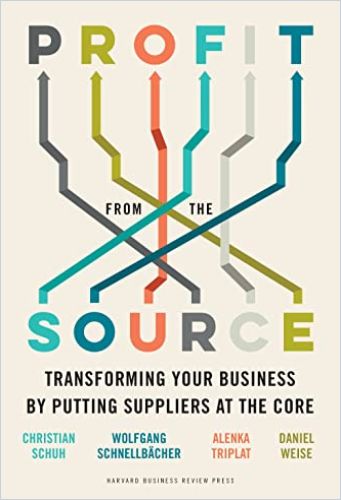Four Boston Consulting Group partners offer a radical – and profitable, they insist – revamping of procurement and of its relationship with the rest of your company.

Procurement Power
Many companies don’t extract the greatest possible value from their procurement department, warn Boston Consulting Group partners Christian Schuh, Wolfgang Schnellbächer, Alenka Triplat and Daniel Weise. Arguing that companies too often regard their procurement team as having only one role – saving money on supplies and manufacturing, they confidently suggest a new paradigm: Integrate your procurement team into product development where its unique expertise can bake savings directly into design and production. Rather than have the procurement team fight suppliers, involve it in the entire product-development process and monetize its insights.
Procurement
Few CEOs devote time or attention to procurement, although this function typically accounts for more than half a company’s budget. And, most chief procurement officers (CPOs) have little input into their company’s strategic planning or product development. This is a waste of expertise.
There is an ongoing, fast-evolving, once-in-a-generation transformation occurring in the way companies operate, and it will reward those CEOs who put suppliers at the heart of their organizations.Christian Schuh, Wolfgang Schnellbächer, Alenka Triplat, Daniel Weiss
Chief executives should have the vision to see procurement as a strategic asset and should recast their suppliers as partners, the authors recommend. That means including the CPO among the CEO’s highest-level advisers and discussing the supply chain at every board meeting.
Take Apple, which does not manufacture anything. It relies on its design talent and its expertise in coordinating a worldwide network of suppliers. Apple achieved dominance in the smartphone market by owning its phone’s intellectual property and turning manufacturing over to its suppliers. Tesla is striving to do the same with its electric cars.
Procurement Professionals
Hire a “catalytic leader” as your CPO – a tough, flexible person who can support and inspire procurement team members. The CPO must augment the team’s skills – including persuasion, diplomacy and strategic planning along with in-depth knowledge of automation, artificial intelligence (AI) and other tools.
[Suppliers] can give you an edge over your rivals by helping you tap all the key sources of competitive advantage: cost savings, innovation, quality, sustainability, speed and risk reduction. Schuh, Schnellbächer, Triplat, Weiss
The procurement department should be made up of three groups: digital creators (AI programmers, automation engineers and data specialists), strategic buyers who negotiate with suppliers, and digital users, who function as operational buyers and perform traditional administrative tasks, such as managing purchasing requisitions. In the new configuration, small groups of operational buyers can oversee automated systems.
Product Development
The CPO and the procurement department should be at the center of your company’s product development process from inception to postproduction. The procurement team can offer its expertise and that of its suppliers to address such questions as: Will the product be difficult to manufacture? Is it innovative? Does it outperform similar products on the market?
For the CPO to be effective, the CEO must provide new paths and procedures for the procurement team. For example, the organization should enable procurement team members to perform a “teardown,” in which they analyze a product by taking it apart, piece by piece, and examining each component. The team should undertake teardowns on each of the company’s products, its competitors’ products and relevant products from companies in “adjacent sectors.”
During this process, the team should ask: Which parts are essential and which could you eliminate? Can you replace certain materials with cheaper, more sustainable ones? The teardown reveals what the product “should cost” on the basis of such variables as materials, labor and profit margins.
The CPO and the procurement team should be there when the design engineer picks up a pencil to start sketching out ideas for a new product, and they should still be there when the last product rolls off the factory production line.Schuh, Schnellbächer, Triplat, Weiss
The procurement department can gather information, interview customers and suppliers, and carry out data analysis on customer behavior. Potential sources include online search records, sales statistics and credit card data.
In addition to saving money, integrating procurement into the development process helps with quality assurance.
For example, at Global Power Synergy, a Thai energy company, procurement traditionally focused on obtaining the best price for fuel for the company’s coal-fired generating plants. But since lower-quality coal produces less heat and thus may not be economical in the long run, Global Power adopted a “total cost of ownership” method, comparing grades of fuel with its boilers’ operating efficiency. It opened a bidding process and measured the bids against the total cost of ownership. Global’s leaders were surprised that investing money in higher-priced coal generated more energy per dollar than the money they spent on lower-priced coal.
Your Supplier Ecosystem
Traditionally, the buyer and supplier relationship has involved battling about specifications and prices. However, the authors teach that you can make this relationship more valuable by collaborating with your suppliers. For example, in return for a promised saving of $26 million in costs, a luxury automobile company helped a supplier assimilate a recent acquisition.
In another example, Apple, which had relied on Samsung, Intel and other suppliers for microchips, began a partnership with TSMC, embarking on a project to design an advanced five-nanometer chip. TSMC spent $10 billion to build the capacity to manufacture the chip.
Toyota uses its keiretsu system to maintain close relationships with suppliers, and it has achieved landmarks in quality and speed. The company exemplifies the benefits of promoting quality through good supplier relationships. It rewards suppliers that pursue continuous improvement by giving them more business. Conversely, suppliers who make errors slip down Toyota’s ladder of preference.
Meeting Your Goals
Modify your supply chain to reflect your goals. For instance, speed up your response to customers by using automation or reducing the bureaucracy around purchasing. Cut costs by developing strategies with each supplier, based on its volume of business with your company and its importance.
Companies pursuing net-zero carbon emissions know that suppliers in such sectors as steel, cement, mining, textiles, agriculture and chemicals generate most of the emissions in their purview. Collaborate with these suppliers to address sustainability issues and seek improvement.
Sustainability is no longer just about doing the right thing. Increasingly, it is about doing business, full stop. Schuh, Schnellbächer, Triplat, Weiss
The authors note that you also can reshape product development to meet your internal goals by using multiple suppliers for particular jobs. For example, the US military sped up production of a successor to the Humvee by employing five different specialized suppliers. That approach reduced a decade-long process to a little less than a year.
A healthy supplier ecosystem offers other potential benefits in research and development, quality, sustainability, resilience, speed and agility.
Preparedness
Events such as the pandemic and various natural catastrophes have disrupted businesses that once saw such crises as unlikely and, therefore, were not prepared and hadn’t confirmed that their suppliers were prepared. To ensure your readiness, monitor your supply chain’s risks and threats. Build overcapacity into your global supply chain in case you need to switch from just-in-time practices to an emergency footing.
A Procurement Revolution
Boston Consulting Group directors Christian Schuh, Wolfgang Schnellbächer, Alenka Triplat and Daniel Weise provide a straightforward, step-by-step manual for transforming procurement into a major player in your organizational strategy in order to cut costs and build for the future. They write without drama and or flashy style, but they don’t need either. Their narrative is a well-organized information bank that showcases the authors’ skill at synthesizing cost and product flow analysis into applicable, productive corporate tactics. That is a rare and valuable skill, and CEOs will value their conclusions.





